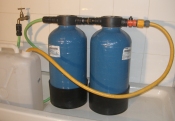If you use a water fed pole system then you will know that the harder the water that you process is, the higher the running costs of your system will be.
Producing pure water fit for use with a water fed pole involves filtering normal water and extracting from it all the chemicals and dissolved solids. Logically, if the water is hard and contains high levels of total dissolved solids (TDS), the filters and resin which work to separate these from the pure water will be consumed and wear out more quickly than if the water is soft and contains very few dissolved solids.
An effective way of immediately producing pure water is by deionising normal water, passing it through a pressure vessel containing mixed bed resin. (Typically referred to as a DI vessel).
D1 Vessel
Using this system pure water is produced on demand very quickly simply by connecting the vessel to the water supply. The main advantage of this method is the speed and simplicity in which you can produce pure water. You generally don’t need a large tank in your van. With the permission of a kind customer, you can refill very quickly on the job or work directly from their tap. Another important advantage is that no water is wasted in the purification process.
However, most window cleaners use a different method of producing pure water – Reverse osmosis.
Merlin Reverse Osmosis Unit
Put simply, reverse osmosis is a process where only pure water is allowed to pass through a membrane and the rest goes down the drain. A typical reverse osmosis unit used by window cleaners involves a 5 stage process, whereby water is first softened, then filtered and finally polished. The process is much slower than a DI set up and so space for a static tank is usually necessary to store the water. Pure water is then transferred to a tank in the van either by gravity or more commonly by a submersible transfer pump. To produce 500 litres of pure water a typical RO unit with a recovery rate of 25% will reject 1500 litres of water, meaning a total of 2000 litres of water used. An average water fed pole user would use 500 litres of water in an 8 hour day. A two man team of window cleaners could get through 1000 litres in a days work. Over the course of one month, that means they could use up to 80,000 litres of drinking water to run their system. Much of the efficiency of the RO unit depends on the mains pressure. The lower the pressure, the higher the rejection rate. So some choose to buy a booster pump to increase efficiency.
Given all the extra expense and added complication using an RO set up, why is it that the majority of window cleaners choose to use this system to produce pure water? The problem lies in the expense involved in using a resin only system. A 25 litre bag of mixed bed resin typically costs £70 – £80 and only produces 5000 – 7000 litres of pure water (where the input water TDS level is 100). Since many window cleaners live in hard water areas, using the resin method on its own would be just too expensive. In a soft water area where the TDS level is less than 100, lets say 50, the resin will last twice as long.
Where two DI vessels are used in series the resin life will be extended even further. (Where only one vessel is used, the resin must be replaced as soon as the output TDS level begins to rise. However, as long as the output TDS level is substantially lower than the input level, this resin can still be used as a pre-filter for a second vessel.)
So in a soft water area, the practical advantages of a DI only set up make it a sensible choice. If only everywhere was a soft water area…….

